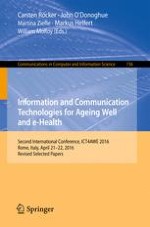2017 | Book
Information and Communication Technologies for Ageing Well and e-Health
Second International Conference, ICT4AWE 2016, Rome, Italy, April 21-22, 2016, Revised Selected Papers
Editors: Prof. Dr. Dr. Carsten Röcker, John O'Donoghue, Prof. Dr. Martina Ziefle, Dr. Markus Helfert, William Molloy
Publisher: Springer International Publishing
Book Series : Communications in Computer and Information Science
